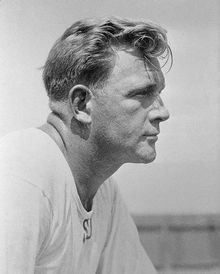

|
|
Ernie Nevers
Date and Place of Birth:
Willow River, Minnesota June 11, 1902
Died: May 3, 1976 San Rafael, California
Baseball Experience:
Major
League
Position:
Pitcher
Rank:
Major
Military Unit:
Area Served:
Pacific Theater of Operations
He later attended He had his greatest college game in the 1925 Rose
Bowl, a 27-10 loss to Notre Dame. Nevers had broken an ankle in
preseason practice in September and didn’t see action until the last
two games of the regular season. He then fractured the other ankle,
but by rigging up a special brace, was able to play in the Rose Bowl
and carried the ball 34 times and netted 114 yards. He also
intercepted a pass that set up the Stanford touchdown and was voted
Rose Bowl MVP. Nevers signed as a pitcher with the St Louis
Browns in 1926. He made his debut on April 26, appearing in 11 games
for a 2-4 record and 4.46 ERA. In the winter of 1926 he played
professional football with the Duluth Eskimos and returned to the
Browns for the summer of 1927, yielding two home runs to Babe Ruth
who was on his way to a record-setting 60. In 1928, Nevers made just six relief appearances
for the Browns, spending the majority of the season with “What ruined me in baseball was a football
injury. I hurt my back and this caused me to alter my pitching
motion. I hurt my arm and that was the end.” In 1929, Nevers joined the NFL’s Chicago
Cardinals as a fullback and coach, remaining with the team until
1931. In 1942, at the age of 40, Nevers joined the
Navy. He was originally assigned duty at Navy Pier in Nevers was promoted to major when he returned
home in late 1944, and assumed duties as base athletic officer at
the Marine Corps Base San Diego. He was honourably discharged from
service in 1945. Nevers was inducted in the College Football Hall
of Fame in 1951 and the Pro Football Hall of Fame in 1963. His son,
Gordie Nevers, played baseball in the Three-I League in the late
1950s, and his grandson, Tom Nevers, was a first round draft pick by
the Astros in 1990. Ernie Nevers died on May 3, 1976 at 
Copyright © 2007 Gary Bedingfield (Baseball in Wartime). All Rights Reserved.